The Evolution of Traditional Instruments
Traditional instruments have played a significant role in music throughout history, providing the melodic and rhythmic foundation for countless cultures and civilizations. Over time, these instruments have evolved and adapted to meet the changing needs and preferences of musicians and audiences. In this article, we will explore the evolution of traditional instruments and how they have adapted over time to remain relevant in the modern music landscape.
The Origins of Traditional Instruments
Traditional instruments have been around for thousands of years, with some of the earliest examples dating back to ancient civilizations such as the Sumerians, Egyptians, and Greeks. These early instruments were often made from natural materials such as wood, bone, and animal hides, and were used in religious ceremonies, celebrations, and everyday life.
As societies advanced and developed more sophisticated technologies, traditional instruments began to evolve as well. The invention of new materials such as metal and synthetic fibers allowed for the creation of more durable and versatile instruments, while advancements in manufacturing techniques made it easier and more cost-effective to produce larger quantities of instruments.
The Influence of Globalization
One of the key factors driving the evolution of traditional instruments in recent years has been the process of globalization. As cultures and music styles from around the world have become more interconnected, musicians have increasingly sought to incorporate elements of traditional music from other cultures into their own compositions.
This cross-pollination of musical styles has led to a renaissance of traditional instruments, with musicians and instrument makers collaborating to create new hybrid instruments that blend elements of different traditions. For example, the sitar, a traditional Indian instrument, has been adapted by Western musicians and incorporated into genres such as rock and jazz.
The Impact of Technology
Advances in technology have also played a significant role in the evolution of traditional instruments. Digital audio processing tools have allowed musicians to enhance and manipulate the sound of traditional instruments in ways that were previously impossible, creating new sonic possibilities and pushing the boundaries of traditional music.
Furthermore, the development of new materials and manufacturing techniques has made it easier for instrument makers to create instruments that are lighter, more durable, and easier to play. For example, carbon fiber has become a popular material for making stringed instruments such as violins and guitars, as it is stronger and more resistant to temperature changes than traditional materials like wood.
The Preservation of Tradition
Despite all of these changes, many musicians and instrument makers remain deeply committed to preserving the traditions and techniques that have been passed down through generations. Traditional instruments are not simply tools for making music; they are a link to the past and a connection to the cultural heritage of a community.
In many parts of the world, efforts are being made to protect and promote traditional instruments and music, whether through educational programs, preservation initiatives, or festivals and performances. By celebrating the rich history and cultural significance of traditional instruments, musicians and audiences can ensure that these important musical traditions continue to thrive for generations to come.
The Future of Traditional Instruments
As we look ahead to the future, it is clear that traditional instruments will continue to play a vital role in the world of music. While new technologies and global influences will undoubtedly shape the evolution of traditional instruments, there will always be a place for the beauty and authenticity of these timeless musical tools.
Whether you are a musician looking to explore new sounds and techniques, an instrument maker seeking to innovate and push the boundaries of your craft, or simply a music lover who appreciates the artistry and history of traditional instruments, there is something truly special about the way these ancient instruments continue to adapt and evolve over time.

Leave a Reply